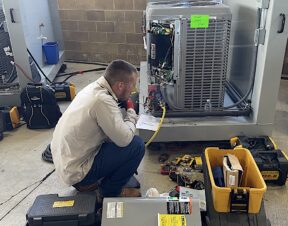Perhaps it was never here to begin with, the sexy part that is. I mean, that’s one of the main knocks on the trades—that it is too demanding. The National Association of Home Builders (NAHB) recently conducted a national poll of young adults ages 18 to 25 to find out how this age group feels about a career in the construction trades. The 63% of undecided young adults who indicated there was no or little chance they would consider a career in the trades no matter the pay were prodded about the reasons for their resoluteness. The two most common reasons: wanting a less physically-demanding job (48%) and the belief that construction work is difficult (32%).
In fact, only 3% are interested in the construction trades, according to the survey. “Unfortunately not a lot of people see the trades as a viable career path. In my market—the DC area—parents want their children to go to college. Shop classes and trade programs have all but disappeared from the local high schools,” says Dan Foley, owner and president of Foley Mechanical, Lorton, Va.

Can the increase of technological sophistication attract young, skilled tradespeople who may want to enter a growing, prosperous and evolving industry? Photo Credit: JCI
That’s the million-dollar question, right? How do we attract skilled workers to the trades? Many in our industry are well aware of the increasing challenge of finding good, well-trained tradespeople to fill many of the jobs that are available today. Well, one of the reasons? This industry has a perception problem.
“I think that we need a brand reboot; we should be the green industry,” says Mark Chaffee vice president of Governmental Relations & Sustainability at Taco Comfort Solutions. Nearly 40% of total U.S. energy consumption is consumed in residential and commercial buildings. “If someone really wants to make a difference in the world, and wants to be ‘green,’ is there really a better industry in which to make a mark?” poses Chaffee.
Think about the opportunity a young contractor, architect or engineer has to influence the built environment. “Our industry’s ‘green sex appeal’ should be highlighted and promoted. Who’s going to design and build the next wave of energy efficient buildings? Who’s going to do the deep retrofits that are going to be required to reduce our energy dependency? And who’s going to make sure we stay comfortable while this all takes place? I think it’s a great call to action!” says Chaffee.
Emphasis on Technology
According to Carl A. Pinto, Jr., director of marketing, Bradford White Corporation, increases in the technological sophistication of water heating equipment, as well as the tools and skill sets required to install and service these products may make certain jobs and the trades in general more attractive to the younger, tech-savvy men and women who want to enter a growing and evolving industry.
It also stands to reason, says Pinto, that as more sophisticated technology is integrated into standard features, there will be a corresponding increase in the skill sets required to install and service this equipment. “Tradespeople who keep their skills up to date and embrace these new technologies will have the best opportunity of increasing their value to customers and with it their demand and income,” says Pinto.
Technology will continue to make it easier for people of all ages to access information and make and implement decisions, whether it’s remotely monitoring the health of mechanical equipment for faster troubleshooting or placing grocery orders online. In business, efficiency almost always leads to increased productivity, driving costs down. “To younger generations, this is an expectation of everyday life. This expectation continues to filter into almost all industries including the trades,” says Dave Desjardins, product manager for Heating and Cooling, Viega.
According to Mark Hudoba, director, heating and cooling marketing and Offerings Department, Uponor Inc., the number of young people going into the trades is decreasing and that decline does not appear to be slowing, let alone changing direction, in the near future. The use of technology will impact every industry and market in some fashion, incorporating it to increase the speed and efficiency of doing business. “Businesses in the hydronics industry must incorporate technology or be surpassed by their competition,” says Hudoba.
Technology brings more of an increased revenue angle than an attraction to the trades angle, intimates Hudoba. “Technology opens the door for incremental revenue for contractors, both in terms of product and service,” says Hudoba. Thermostats with remote accessibility and control are becoming commonplace, allowing contractors to upsell from the standard thermostats. Remote monitoring services, continues Hudoba, are an additional opportunity to increase revenue and provide more value to building owners.
“As far as new gadgets and the technology such as the Internet of Things (IoT)—yes it’s coming. I don’t think it’s coming to our industry very fast but we will be brought along as the rest of the built environment becomes more connected, smarter, and as sensors are placed everywhere,” says Chaffee. You can already control your thermostat by phone, turn on heating and cooling automatically as you get close to your house, and access information on web-enabled pumps and boilers.
“Besides the cool apps, I see a lot more focus being put into providing information to the service companies before they ever show up on a job—for predictive problem-solving,” continues Chaffee. The greater use of smart equipment will result in better remote diagnostic capabilities. Why have to show up to a job just to find out that a sensor is bad and you have to go the wholesaler to pick one up and then go back to the job? “We’re soon going to see the day when a service pro gets a text from the piece of equipment that the sensor has gone. There’ll be a one-click order ability for the part so that he or she can show up on the job once, with the right part in the truck—ready to install. The future isn’t that far away,” says Chaffee.
More on that NAHB study: Most of the young people interested in the trades say the two most important benefits of this career choice are good pay (80%) and the attainment of useful skills (74%). The trades will require a higher level of knowledge with the growing sophistication of controls, enhanced to improve system performance, more intelligent diagnostics, and even connectivity to smart phones and other portable devices, for example.
There’s no doubt that today—and even more so in the future—the fields of designing, troubleshooting, servicing and installing hydronic systems, for instance, offer stable careers for those that like to combine hands-on work with the need for clever problem solving, says Chuck O’Donnell director of marketing, Laars Heating Systems Co. “I believe the key is educating youth while in high school to show those who like hands-on work and problem solving that there is indeed a path for them, and if done correctly, a very profitable path!” says O’Donnell.




Join the conversation: